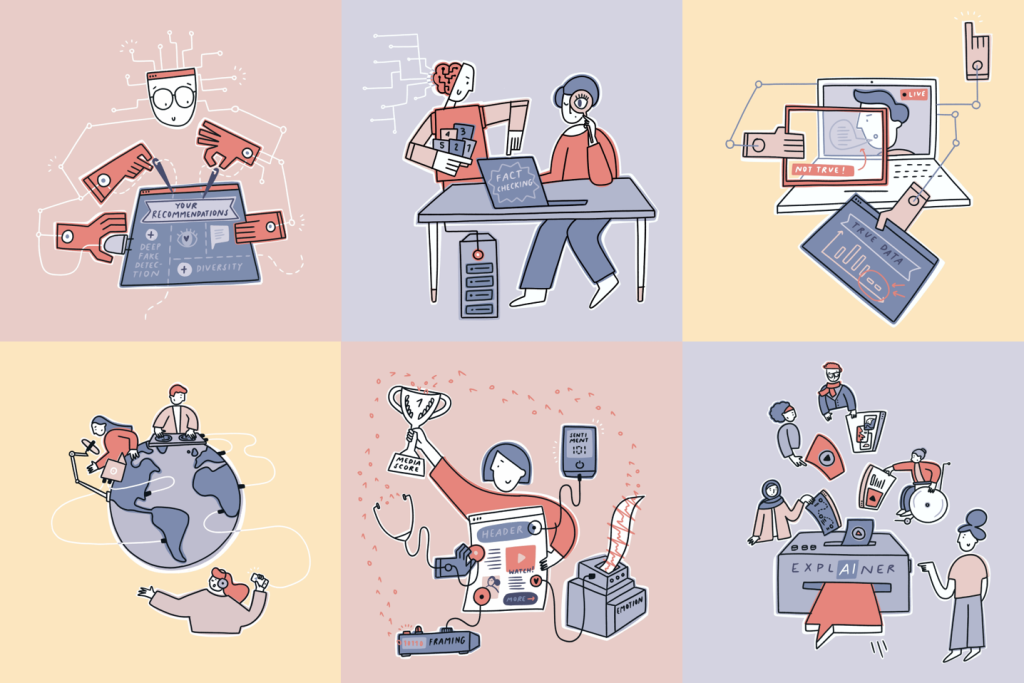From speculations to future applications: AI4Media publishes scenarios envisioning the future horizons for AI in media
Authors: Rasa Bocyte and Johan Oomen, Netherlands Institute for Sound & Vision
News recommender systems that put the audience in the driver’s seat, highly personalised fact-checks and automatically created podcast mixtapes – these are just a few ideas captured in the booklet Exploring AI Potential and Collaborations in the Evolving European Media Landscape. The new publication, created by the AI4Media Centre of Excellence team, presents nine scenarios that capture future innovation directions in the media sector.
The publication is a result of a speculative design process – a series of creative workshops that brought media organisations, AI developers and researchers to co-create future-oriented scenarios of using AI in the media sector. Using future thinking and design thinking approaches, experts worked in interdisciplinary teams to reflect on the current use of AI in the media sector and imagine what they would like to see in this field in the near future.
Over fifty participants from a wide range of media backgrounds took part in this process facilitated by the Netherlands Institute for Sound & Vision and ZEZA. The scenarios are based on the extensive catalogue of AI techniques and software developed by the AI4Media project.
Imaging and building desirable futures
But why speculative designs? As new AI techniques emerge and mature, they open possibilities for new application areas that bring societal benefits as well as introduce new risks. This prompts the industry and the research community to chart new territories: what future use cases and scenarios can we imagine for these technologies? What new business opportunities will they create for the media sector? How can they learn from recent misuse of AI-driven applications and create applications that support public values? By crafting speculative scenarios, we can foresee potential risks and choose alternative paths.
The exercise of speculative design can also help with the persistent challenge of bridging the gap between fundamental AI research and practical applications. It helps researchers and industry representatives get a better understanding of each other’s perspectives and tailor the development of AI-based solutions towards specific societal needs and challenges.

Illustrator: Magda Rysuje
The scenarios presented in the booklet are designed to spark inspiration among researchers and media professionals, encouraging them to bridge the gap between cutting-edge AI research and the pressing challenges confronting the European media sector. To facilitate this, each scenario is complemented by links to relevant technologies developed by AI4Media partners. While these scenarios are not immediate market-ready solutions, they serve as a vision of the future potential of technologies in the AI4Media ecosystem.
Embedded in AI4Media
The publication’s ambitions are aligned with the overall strategy of the AI4Media Centre of Excellence (CoE). Funded by the Horizon 2020 Programme, this ambitious initiative delivers next-generation AI research and training at the service of media, society and democracy. The CoE brings together researchers, developers and media professionals from across the EU to translate fundamental AI research into concrete solutions to support the media industry value chains now and in the future.
Over the past years, AI4Media explored seven use cases that cover a variety of topics such as disinformation, news research and production, media moderation, organisation of audiovisual archives, game design, human-machine artistic co-creation, and social sciences research. The AI4Media Observatory supports multidisciplinary community collaboration and fosters broader discussions on AI’s development, impact, and societal implications.
A call for feedback
AI4Media seeks collaboration with media partners and small to medium enterprises for further testing of the technologies presented in the booklet and to gather feedback from media professionals. If you’re interested in collaborating, please contact us at info@ai4media.eu.

